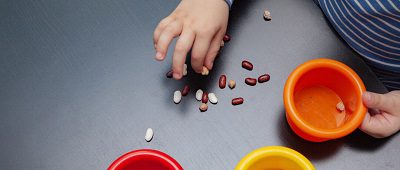
When your child becomes a toddler, you may suddenly begin hearing about fine-motor skill development. There are many ways to develop fine-motor skills, and they are often discussed as if writing is the ultimate outcome. Yet, getting through a day without using your fine-motor skills would be very difficult. We use fine-motor skills, those small movements we make with our hands, fingers, and arms to manage buttons, zippers, and tying when we get dressed, to feed ourselves, turn pages of books or magazines, and keyboard, text, and use the remote, all of that before we have written anything!
New research from Georgetown University (Cortes et al., 2022) demonstrates that fine-motor skill development at 42 months of age correlates to visuospatial deductive reasoning in adolescence. Visuospatial refers to being able to compare two- and three-dimensional objects and deductive reasoning; in this case, it refers to being able to pick which object or drawing from given choices should come next in the series. Although brain imaging continues to improve and those improvements continue to provide more detailed information, brain imaging has shown that motor skills, reasoning, and spatial cognition share common areas in the brain (Cona & Scarpazza, 2019). The ability to make inferences is connected to visuospatial deductive reasoning. For example: Kim ran home. When she got there, she had to stop to catch her breath and wipe perspiration from her face and neck. Did Kim run home quickly or run slowly?
In a Montessori 3-6 classroom, students develop their fine-motor skills through many different materials. The Practical Life area of the classroom develops a variety of fine-motor skills, from the Dressing Frames to pouring and scooping. The materials in the Sensorial area also actively utilize fine-motor skills, such as the pincer grip with the Cylinder Blocks and careful carrying of the cubes of the Pink Tower, Red Rods, and Brown Stairs. The Metal Insets, a language work which creates the movements that form all the letters of the alphabet, also develop fine-motor skills. Using pencils and cutting with scissors also develop fine-motor skills in the hand.
How can fine-motor skills be developed at home? Allowing your child to perform daily tasks, even though it takes longer, is important. Feeding themselves to the best of their ability, wiping down their eating area, and dressing themselves are all opportunities for fine-motor skill development.
Other work options you can create at home:
Art opportunities: lacing beads or pasta on string; drawing in shaving cream; all coloring and painting; playdough or other moldable mixtures.
Water opportunities: using a turkey baster to move water from one container to another (or from a small bucket to a garden); making bubbles with a whisk, a squirt of liquid soap, and some water.
Other opportunities: opening and closing small jars or other containers; pushing uncooked spaghetti through the holes of a colander; scooping uncooked rice or beans from one container to another.
Seventy-six years ago, Dr. Montessori was leading us to the same conclusion as today’s research, using different means of observation. She reminded us, “The hands help the development of the intellect. When a child can use his hands, he can have a quantity of
experiences in the environment through using them. To develop his consciousness, then his intellect, and then his will, he must have exercises and experiences.” (Montessori, 2012, page 130) •
RESOURCES
Cona G. & Scarpazza, C. (2019). Where is the “where” in the brain? A meta-analysis of neuroimaging studies on spatial cognition. Human Brain Mapping, 40(6), 1867-1886.
Cortes, R. A., Green, A. E., Barr, R. F., & Ryan, R. M. (2022, March 31). Fine-motor skills during early childhood predict visuospatial deductive reasoning in adolescence. Developmental Psychology. Advance online publication.
Montessori, M. (2012). The 1946 London Lectures. Montessori-Pierson Publishing Company.
Cheryl Allen was a classroom Montessori guide for 18years and is now Director ofParent Education with the Montessori Family Alliance. As a child, Cheryl attendeda Montessori school from age 2 through the3rd grade. She earned her BA in History fromGeorgetown University and her Master’s inTeaching from Simmons College in Boston.Cheryl is an AMS-certified Early Childhoodand Elementary Montessori teacher, holdsIMC certification in advanced ElementaryMontessori education, and is currentlypursuing a Topics of Human BehaviorGraduate Certificate from Harvard University.






